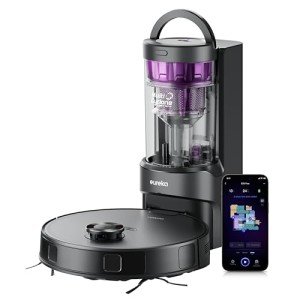15 Terms Everyone Who Works In Robot Hoover Industry Should Know
The Evolution of Robot Hoovers: Revolutionizing Home Cleaning
Robot hoovers, also called robotic vacuum cleaners, have transformed how people approach home cleaning jobs. At first introduced in the late 1990s, these self-governing machines have actually developed quickly due to improvements in innovation, synthetic intelligence, and maker knowing. Today, they are equipped with an array of functions that make them extremely effective in maintaining tidiness in living areas. This article checks out the history, working, benefits, and future of robot hoovers.
The History of Robot Hoovers
The concept of robotic vacuums go back to the 1970s, but it wasn't up until the launch of the Roomba by iRobot in 2002 that they got mainstream attention. The Roomba was designed to automatically navigate different surface areas, avoiding challenges while effectively cleaning floors. Ever since, numerous substantial advancements have actually occurred, including:
Year
Advancement
1996
First model robotic vacuum established by a Japanese company.
2002
iRobot releases the Roomba, mass popularizing robotic vacuums.
2004
Intro of the first Roomba with a dirt detection sensor.
2011
Introduce of models with cordless capabilities and smart device combination.
2020
Advanced models including AI, improved navigation systems, and mopping abilities.
How Robot Hoovers Work
Robot hoovers run on a combination of sensing units, electronic cameras, and algorithms that allow them to clean efficiently. Key elements of these devices consist of:
Sensors:
- Obstacle Avoidance Sensors: Detect walls, furniture, and even stairs, avoiding accidents and falls.
- Dirt Detection Sensors: Identify areas that need more thorough cleaning.
Navigation:
- Gyroscopes: Help figure out the robot's orientation and movement.
- Cameras and Lidar: Enable mapping of the home environment to develop optimal cleaning courses.
Cleaning Mechanisms:
- Vacuum Motors: Generate suction to get dirt and particles.
- Brush Rollers: Agitate dirt out of carpets for deeper cleaning.
Power Supply:
- Batteries: Rechargeable lithium-ion batteries offer the required power for extended cleaning cycles.
User Interface:
- Mobile Apps and Smart Home Integration: Users can arrange cleansings, display performance, and control the robot from another location.
Advantages of Robot Hoovers
Robot hoovers use numerous benefits, making them an enticing choice for modern families:
- Time-Saving: Automated cleaning enables users to concentrate on other tasks while the robot effectively cleans floorings.
- Convenience: Many designs can be arranged for cleaning sessions, making sure that homes stay tidy without manual effort.
- Availability: Ideal for individuals with movement obstacles or hectic way of lives, making it possible for much easier home maintenance.
- Consistent Cleaning: Regular, automated cleansings decrease the accumulation of dirt and allergens, adding to a much healthier living environment.
- Smart Technology: Integration with smart home systems enables increased control and personalization.
Limitations of Robot Hoovers
In spite of their benefits, robot hoovers feature particular restrictions:
- Navigation Challenges: They may have a hard time in cluttered areas or with particular floor types such as high-pile carpets.
- Battery Life: Most designs require routine charging, which can restrict cleaning duration.
- Maintenance: Regular cleaning of filters, brushes, and emptying dust bins is necessary for optimum efficiency.
- Price: Advanced models can be pricey compared to standard vacuum cleaners.
The Future of Robot Hoovers
As innovation continues to develop, the future of robot hoovers looks promising. Anticipated improvements include:
- Improved AI: Enhanced algorithms will allow for better object recognition and vibrant mapping of spaces.
- Hybrid Models: Integration of vacuuming and mopping abilities in one gadget will offer a detailed cleaning service.
- Increased Autonomy: Future models might browse even the most complicated environments without human intervention.
- Sustainability: Battery innovation improvements will result in longer-lasting, more energy-efficient robots.
Regularly Asked Questions (FAQs)
1. Are robot hoovers efficient for pet hair removal?
Yes, numerous robot hoovers are particularly developed to take on family pet hair with effective suction and specialized brushes that lower tangling.
2. How do robot hoovers navigate around furnishings?
Robot hoovers utilize a mix of sensing units and electronic cameras to identify obstacles, permitting them to browse around furniture and avoid crashes.
3. Can robot hoovers tidy carpets?
The majority of modern robot hoovers work on both difficult floorings and carpets. It is advisable to check the specs of specific models for specific performance.
4. Do robot hoovers require programming?
Many robot hoovers feature easy to use apps that enable owners to set schedules and customize cleaning preferences, making shows uncomplicated.
5. Just how much do robot hoovers cost?
Rates for robot hoovers differ extensively, ranging from ₤ 200 to around ₤ 1,500, depending upon functions and brand name.
Robot hoovers have come a long way because their beginning, offering an effective and hassle-free cleaning solution for modern homes. Their increasing ability and intelligence make them a useful choice for individuals looking to streamline their cleaning routines. As robotic vacuum cleaner sale continues to advance, robot hoovers will likely end up being even more capable, offering additional functions that cater to the progressing needs of users. Their journey from novelty to necessity highlights a basic shift in how society approaches home upkeep, marking a considerable turning point in the crossway of innovation and life.
